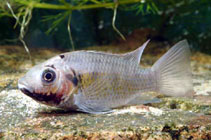| Family: |
Cichlidae (Cichlids), subfamily: Pseudocrenilabrinae |
| Max. size: |
28 cm SL (male/unsexed) |
| Environment: |
demersal; freshwater; brackish; marine; pH range: 7 - 8; dH range: 9 - 19; depth range 0 - 3 m |
| Distribution: |
Africa: Lagoons and estuaries from Mauritania to Cameroon. Introduced to several countries in Asia, USA and Europe (Ref. 21). At least one country reports adverse ecological impact after introduction. Previously, three subspecies were recognized: Sarotherodon melanotheron heudelotii, Sarotherodon melanotheron leonensis and Sarotherodon melanotheron melanotheron. |
| Diagnosis: |
Dorsal spines (total): 15-17; Dorsal soft rays (total): 10-12; Anal spines: 3-3; Anal soft rays: 8-10; Vertebrae: 26-28. Diagnosis: length of caudal peduncle 0.6-0.9 times in its depth (Ref. 53405). Melanic areas in adult usually present on lower parts of head, on cleithrum and on apices of caudal and soft dorsal fins; occasional irregular and asymmetrical spots on flanks probably representing vertical bars; median spot or transverse bar on nape rather constant (Ref. 2).
Description: jaw teeth in 3-6 rows, outer row in upper jaw with 46-100 bicuspid teeth; outer jaw teeth bicuspid; inner jaw teeth tricuspid; lower pharyngeal bone long and narrow, its toothed part with fine, bicuspid teeth; micro-gillrakers present; scales cycloid (Ref. 53405).
Coloration: in life: ground colour pale opalescent blue, each scale with darker or golden spot at base; 2-3 scale rows on back iridescent yellow; gill cover transparent in mature females, gills shining through and giving a purple appearance; chin, opercle and part of subopercle metallic golden in mature males; deep black spots on lower jaw, branchiostegal membrane, underside of head, above eye, on neck, cleithrum (from upper end to below pectoral-fin bases), and often 1-2 on sides; these often asymmetric spots darker and larger in mature males, but absent in juveniles; dorsal and anal fins with more or less distinct spots against iridescent greenish background; soft parts of fins often black-edged in mature individuals; caudal fin translucent, colourless or mauve, with deep-black angles; pectoral fins colourless, pelvics dark with white margin; "tilapian" spot present in juveniles, but disappears at sizes of 50mm SL (Ref. 53405). |
| Biology: |
This species can tolerate high salinity (Ref. 5723). It occurs abundantly in mangrove areas and ventures in to both fresh, like lower reaches of streams (Ref. 5723) and salt waters in native and non-native ranges (Ref. 46816, 53405). In West Africa, this species is confined to brackish lagoons and estuaries, and is abundant in the mangrove zone (Ref. 2). Forms schools; is mainly nocturnal with intermittent daytime feeding. Feeds on aufwuchs and detritus (Ref. 2), as well as on bivalves and zooplankton (Ref. 28587). Feeding behaviour: picking up and swallowing "bites" (no gill rakers) (Ref. 55661). |
| IUCN Red List Status: |
Least Concern (LC); Date assessed: 22 April 2019 Ref. (130435)
|
| Threat to humans: |
potential pest |
Source and more info: www.fishbase.org. For personal, classroom, and other internal use only. Not for publication.
